Drosera × badgerupii Cheek
The epithet badgerupii is derived from the indigenous Australian Noongar word badgerup, the English meaning of which is unknown. This indigenous name has been used for two conjoined bodies of water, Lake Badgerup and Little Badgerup Swamp.
Drosera × badgerupii is a Western Australian endemic natural hybrid between Drosera micra and Drosera patens, it is now extinct in the wild. This hybrid has been known as Drosera occidentalis × nitidula subsp. omissa.
This plant grows in peaty sand or pure peat on the margins of swamps and lakes.
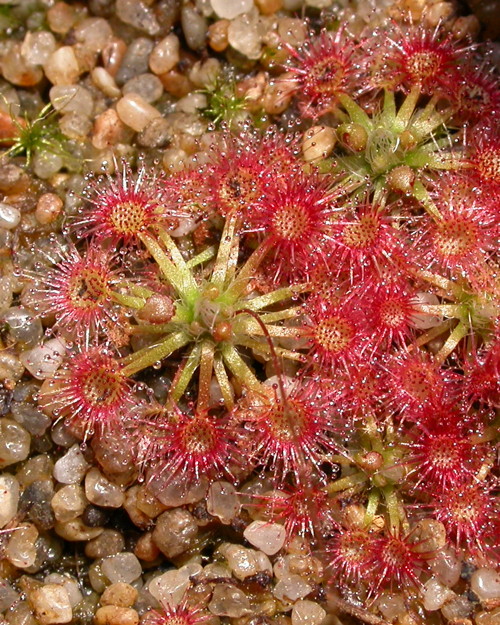
Drosera × badgerupii. Photo by John Brittnacher.
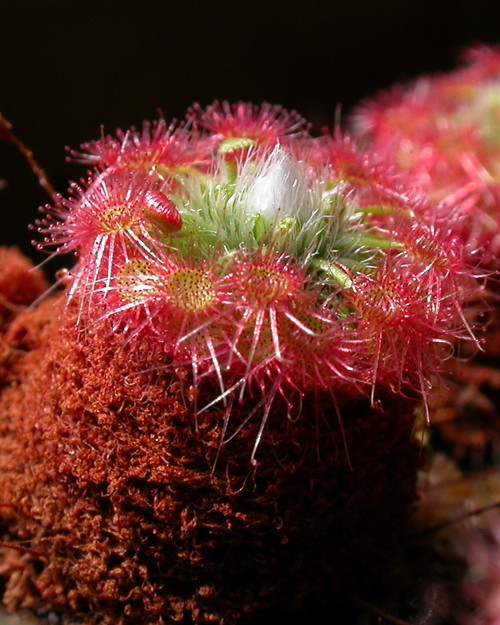
Drosera × badgerupii. Photo by John Brittnacher.
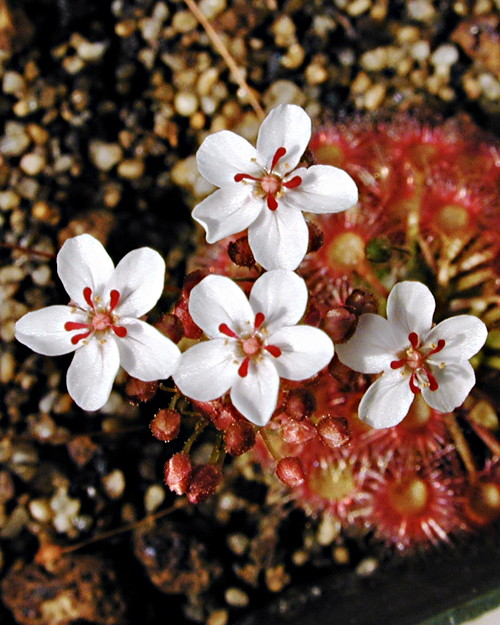
Drosera × badgerupii. Photo by John Brittnacher.
Drosera × badgingarra Lowrie & Conran
The epithet badgingarra is derived from the indigenous Australian name for the pool of water on the river located opposite the old town site of Badgingarra, about 5 km east of Moora. This feature was recorded by surveyor Alexander Forrest in 1877. The indigenous Australian word badgingarra is said to mean “water by the manna gums”. The present town site of Badgingarra, gazetted in 1955, is situated on the Brand Highway near the area in which this natural hybrid is found.
Drosera × badgingarra is a Western Australian endemic natural hybrid between Drosera allantostigma and Drosera omissa. It is known only from the type locality, Badgingarra. This hybrid has been known as Drosera nitidula subsp. alantostigma × ericksoniae.
This plant grows on the margins of wet depressions in clay rich sand soils.
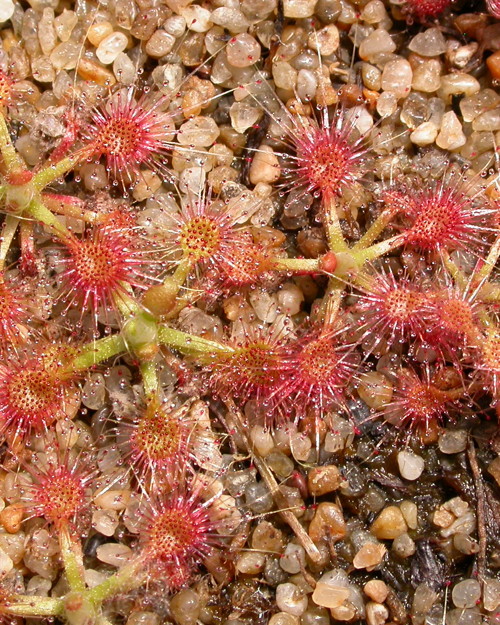
Drosera × badgingarra. Photo by John Brittnacher.
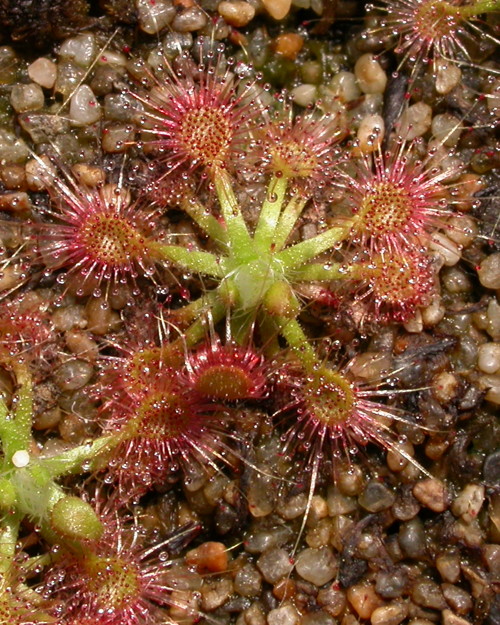
Drosera × badgingarra. Photo by John Brittnacher.
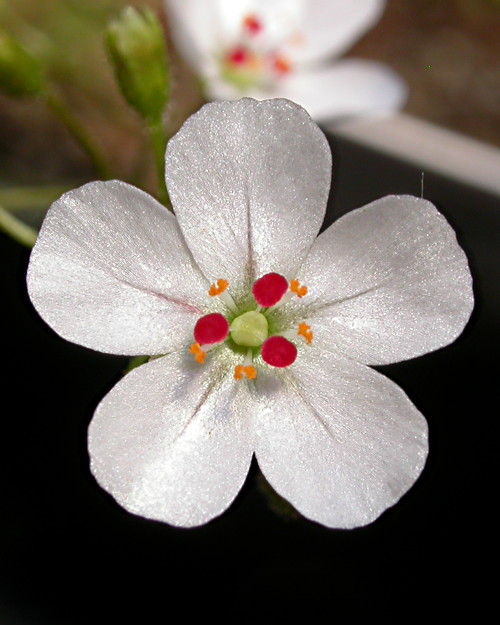
Drosera × badgingarra. Photo by John Brittnacher.
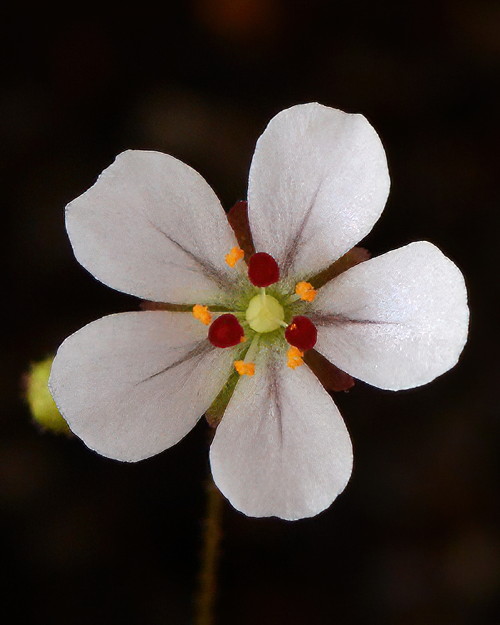
Drosera × badgingarra. Photo © Richard Nunn.

Drosera × badgingarra. Photo by John Brittnacher.
Drosera × carbarup Lowrie & Conran
The epithet carbarup is an indigenous Australian name, the meaning of which is unknown. The name refers to the area in which this sterile natural hybrid between Drosera occidentalis and Drosera platystigma is found.
Drosera × carbarup is known only from its type location in Carbarup, Western Australia.
It grows in laterite and sand soils in winter-wet depressions with dwarf paperbark trees (Melaleuca sp.).
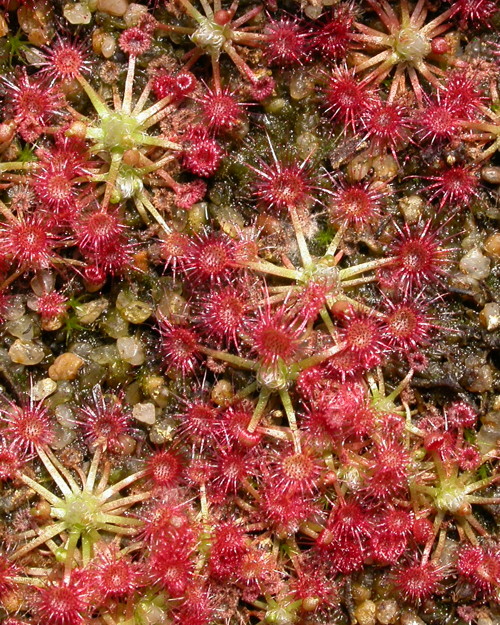
Drosera × carbarup. Photo by John Brittnacher.
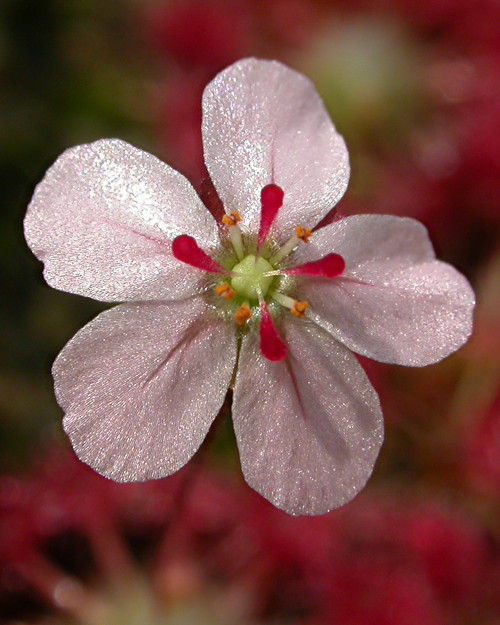
Drosera × carbarup. Photo by John Brittnacher.
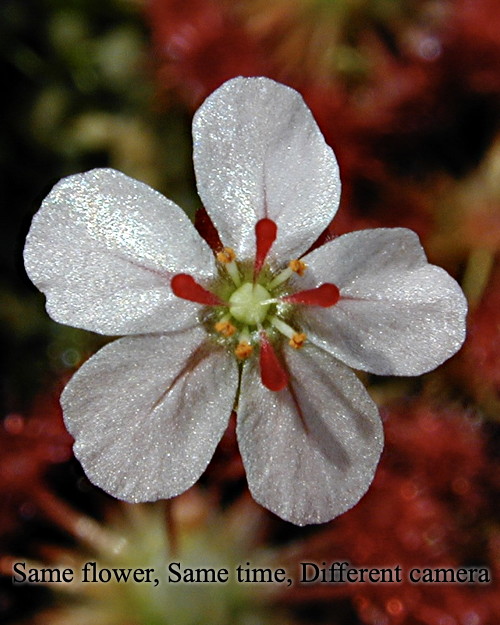
Drosera × carbarup. Photo by John Brittnacher.

Drosera × carbarup. Photo by John Brittnacher.
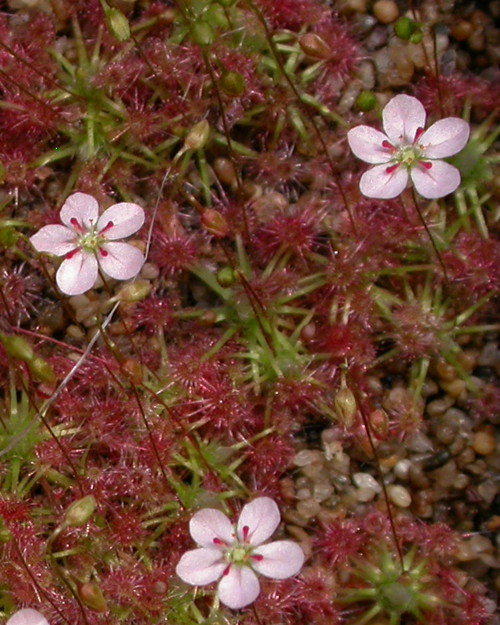
Drosera × carbarup. Photo by John Brittnacher.
Drosera × legrandii Lowrie & Conran
The epithet legrandii honours Ensign Le Grand, a very competent young crew member of the D’Entrecasteaux expedition (1792) who directed the Espérance, from the top of its mast, safely through a maze of dangerous and then uncharted reefs into Esperance during a gale. The companion ship on the expedition, Recherche, followed the same passage to safe anchorage. Both ships were thus saved from potential disaster. The region in which this natural hybrid was discovered, Cape Le Grand, was named by the French also in honour of Ensign Le Grand.
Drosera × legrandii is known from Western Australia, and only from the type location in Cape Le Grand, Western Australia.
This plant is a sterile natural hybrid between Drosera nitidula and Drosera australis. This hybrid has been known as Drosera nitidula subsp. nitidula × occidentalis.
It grows in black silty sand on swampy heathland.

Drosera × legrandii. Photo © Thilo Krueger.
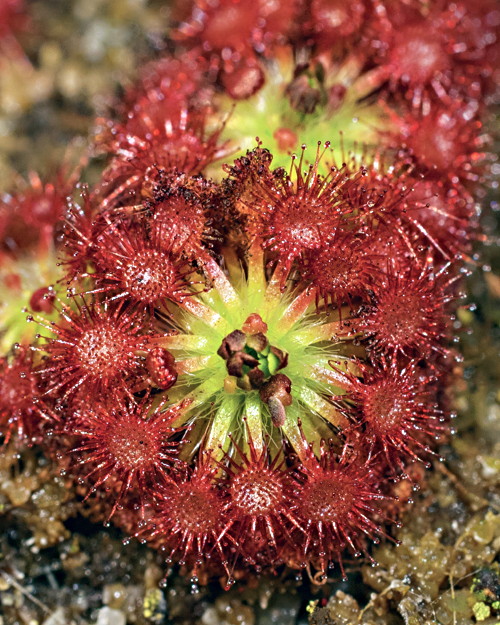
Drosera × legrandii. Photo © Manfred Meisterl.
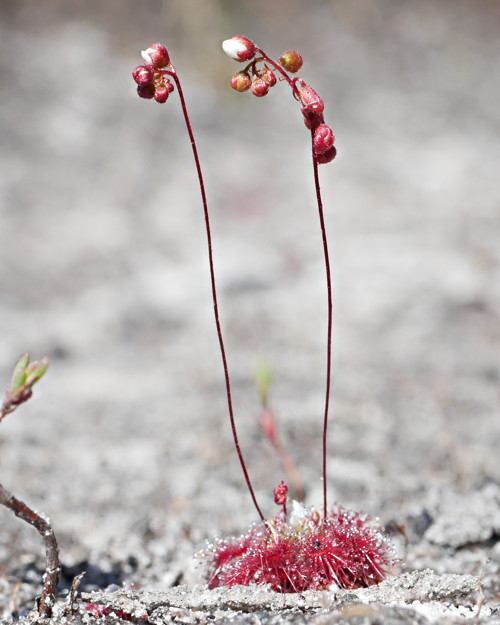
Drosera × legrandii. Photo © Thilo Krueger.
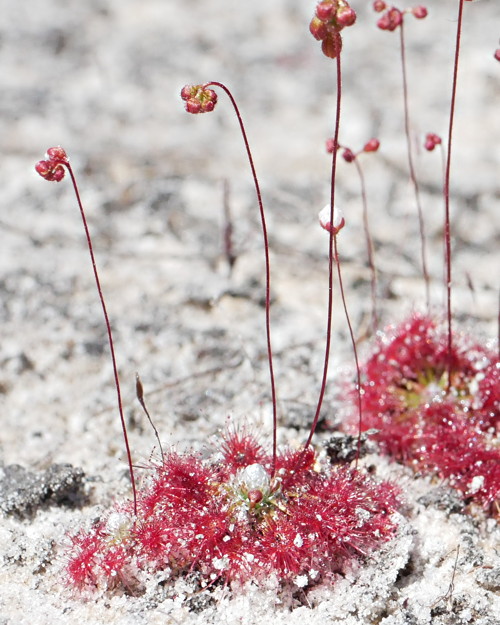
Drosera × legrandii. Photo © Thilo Krueger.
Drosera × pingellyensis Lowrie & Conran
The epithet pingellyensis refers to the township Pingelly, near which this taxon occurs. The indigenous Australian name for the area before settlement was Pingecullring.
Drosera × pingellyensis is known only from the type location near the township of Pingelly, Western Australia. It is a hybrid between Drosera nitidula and Drosera omissa. This hybrid has been know as Drosera nitidula subsp. nitidula × ericksoniae.
It grows on the margins of wet depressions in white sandy soils.
Drosera × sidjamesii Lowrie & Conran
Drosera × sidjamesii is named in honour of the late Professor Sid James (1933–1998), formerly of the Botany Department at the University of Western Australia, who studied cytological evolution in Western Australian flora which is a hybrid between Drosera patens and Drosera pulchella. He had been working on the hybrid and its origins at his death. This hybrid has been known as Drosera nitidula subsp. omissa × pulchella.
Drosera × sidjamesii is known from Western Australia, with records from three locations, two spread over a 21.25 kilometre distance in the Perth metropolitan area between Wanneroo and Beechboro, with the Lake Gnangarra type location situated in between.
It grows on the margins of swamps, lakes and winter-wet depressions in sandy soils.

Drosera × sidjamesii. Photo © Richard Nunn.
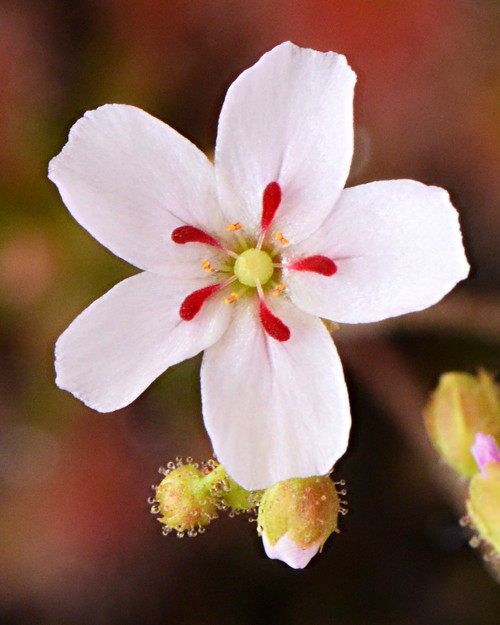
Drosera × sidjamesii. Photo © Richard Nunn.

Drosera × sidjamesii. Photo © Thilo Krueger.

Drosera × sidjamesii. Photo © Thilo Krueger.
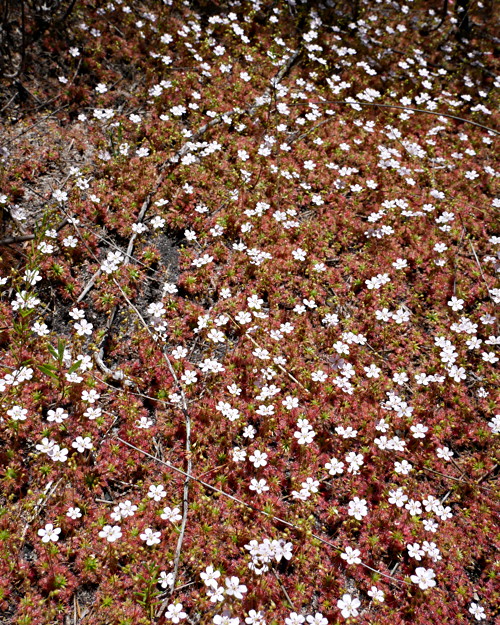
Drosera × sidjamesii. Photo © Thilo Krueger.
